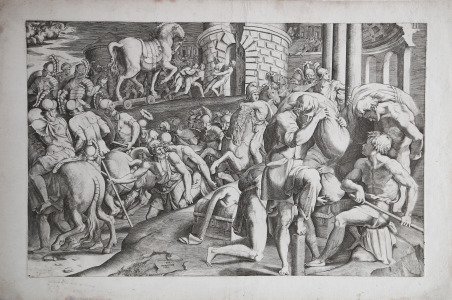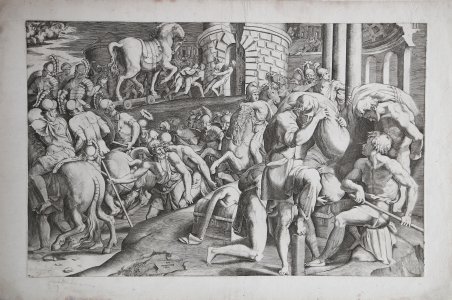Bulino, datata e inscritto in lastra, in basso al centro: 'BOL/INVENTORE/1545/IV BONASONIS F'. Da un soggetto attribuito al Primaticcio. L'incisione è stata eseguita con due lastre. Rappresenta la scena della guerra di Troia raccontata da Virgilio (Eneide, 2, 99 e seguenti), in cui i Troiani spingono all’interno delle mura della città il grande cavallo ligneo lasciato ingannevolmente dai Greci per propiziare gli dei, ma nel cui interno si nascondono soldati pronti all’attacco. Quella notte i soldati greci nascosti nel cavallo aprono le porte della città ai loro compatrioti, e Troia cade. Secondo Massari, la stampa deriva direttamente da un disegno danneggiato, in controparte, oggi a Windsor, Royal Library, inv. no. 5139, attribuito a Francesco Primaticcio da Popham e Wilde. Bruce Davis ha supposto che Giulio Bonasone potrebbe aver incontrato Primaticcio a Roma quando venne ad acquistare antichità per Francesco I. Cirillo Archer in TIB suggerisce che sia il disegno che la stampa traducono un dipinto perduto di Primaticcio, una volta forse nella Galerie d'Ulysse a Fontainebleau. Secondo Davis, la stampa potrebbe riflettere un'idea iniziale per la serie dalla vita di Ulisse, che alla fine iniziò con Il sacco di Troia. Il secondo stato fu pubblicato da Pietro de Nobili, il terzo da Carlo Losi che r aggiungono il loro indirizzo in basso a sinistra. Il presente esemplare, verosimilmente nel terzo stato finale, presenta segni di abrasione nell’area che accoglieva l’indirizzo editoriale. Ottimo esemplare, stampato su carta vergata e filigranata coeva, ampi margini, in perfette condizioni. Engraving, signed, dated and inscribed on a tablet lower centre: 'BOL/INVENTORE/1545/IV BONASONIS F'. After Primaticcio. The engraving was executed using two plates. It represents the scene from Trojan War recounted by Virgil (Aeneid, 2, 99 ff). The Trojan, thinking that after ten years the Greeks have lifted their siege and departed, find outside gate a wooden horse left as an offering to the Trojans’ gods. The horse is shown being brought into the city gate. That night the Greek soldiers hidden inside the horse open the gates to their compatriots, and Troy falls. According to Massari, the print derives directly from a damaged drawing in reverse, today in Windsor, Royal Library, inv. no. 5139, attributed to Francesco Primaticcio by Popham and Wilde. Bruce Davis supposed that Giulio Bonasone might have met Primaticcio in Rome when he came to acquire antiquities for Francis I. Cirillo Archer in TIB suggests that both drawing and print record a lost painting by Primaticcio, once perhaps in the Galerie d'Ulysse at Fontainebleau. According to Davis, the print might reflect an initial idea for the series from the life of Ulysses, which he eventually initiated with The Sack of Troy. The second state was published by Pietro de Nobili, the third by Carlo Losi. The present example, probably in the third final state, shows signs of abrasion in the area that held the editorial address. Very good example, printed on contemporary laid and watermarked paper, wide margins, in perfect condition. Cfr. Cirillo Archer in TIB 1995, 2803.085.S1; Bartsch XV.134.85; Massari 1983, no. 43.


Scopri come utilizzare
Scopri come utilizzare

